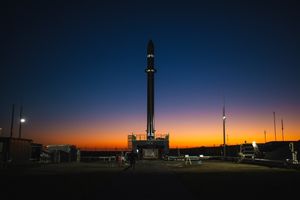- Annual Shareholders Meeting highlights company’s plans to play a leading role in the energy transition
- Strategy focused on five priorities to sustainably grow shareholder value
- Streamlined business structure to take advantage of technology, scale and integration
ExxonMobil said today it plans to grow shareholder value by delivering solutions that help meet the global need for energy and for lower greenhouse gas emissions to address climate change. Darren Woods, chairman and chief executive officer, outlined how the company’s strategy leverages its capabilities and competitive advantages at the annual meeting of shareholders.
“We have opportunities to play a leading role in helping society achieve its net-zero ambitions and in meeting the world’s growing demand for energy and essential products,” said Woods. “Recent events have reminded us how globally connected energy markets are. They’ve also underscored the importance of our role in creating sustainable solutions that improve quality of life, while supporting a lower- emissions future.”
ExxonMobil in April streamlined its business structure to consist of three core businesses – Upstream, Product Solutions and Low Carbon Solutions – to fully leverage the company’s competitive advantages of scale, integration, technology, functional excellence and highly skilled workforce.
ExxonMobil is focused on five key strategic priorities to sustainably grow shareholder value:
- Leading industry in financial, operational and environmental performance, including across key metrics of safety, reliability, greenhouse gas emissions intensity reductions, earnings and cash flow growth.
- Being an essential partner through creation of innovative solutions for customers, partners and stakeholders.
- Upgrading the company’s advantaged portfolio to ensure it leads competition and delivers value across a range of external environments and through volatile and evolving markets.
- Continuing to innovate, providing solutions that meet the growing needs of society reliably and affordably. This means new products, technologies and approaches that better meet today's and tomorrow's needs and can be deployed at scale to create meaningful impact.
- Developing the company’s workforce and maintaining a diverse and engaged organization that provides every individual unrivalled opportunities for personal and professional growth with impactful work meeting society’s evolving needs.
Woods highlighted the company’s strong performance in 2021, noting that earnings significantly improved to $23 billion and cash flow from operating activities totaled $48 billion, the highest since 2012. Future plans include structural cost savings of $9 billion per year by 2023, compared to 2019, and more than $15 billion of investments through 2027 on initiatives to lower greenhouse gas emissions. They include investments to reduce emissions from company operations and to advance critical technologies like carbon capture and storage, hydrogen and biofuels, which together are expected to develop into multi-trillion-dollar markets in the decades ahead.
“Long-term, we have the portfolio flexibility necessary to pace our investments consistent with advancements in technology, markets and supportive policy,” Woods said. “As we move forward, we’ll remain focused on executing our strategy, sustainably growing value across a broad range of scenarios and time horizons, and importantly, leading the industry, now and through the energy transition.”
In the near term, ExxonMobil is increasing production of the energy resources and products the world needs.
For example, in Guyana, the company has two oil fields in production and two more in development, and made new discoveries that increased the estimated recoverable resource to nearly 11 billion barrels of oil equivalent.
In the Permian Basin in the United States, ExxonMobil expects to produce more than 550,000 oil equivalent barrels per day this year, which would represent a production increase of 25% on top of the increase achieved in 2021. The company’s state-of-the-art Corpus Christi chemical complex started production on schedule and under budget and delivered positive earnings and cash flow in its first quarter of operations.
ExxonMobil continues to mitigate emissions from its operations and achieved its 2025 emission-reduction plans four years earlier than planned. This progress supports the company’s more aggressive 2030 greenhouse gas emission-reduction plans and its ambition to achieve net-zero scope 1 and 2 greenhouse gas emissions from operated assets by 2050.
During the annual meeting, shareholders re-elected ExxonMobil’s board of director nominees, supported the company’s executive compensation program, ratified PricewaterhouseCoopers LLP as independent auditors and passed one proposal by shareholders. The proxy voting results will be made available on the company’s website as soon as practical.
About ExxonMobil
ExxonMobil, one of the largest publicly traded international energy and petrochemical companies, creates solutions that improve quality of life and meet society’s evolving needs.
The corporation’s primary businesses - Upstream, Product Solutions and Low Carbon Solutions - provide products that enable modern life, including energy, chemicals, lubricants, and lower-emissions technologies. ExxonMobil holds an industry-leading portfolio of resources, and is one of the largest integrated fuels, lubricants and chemical companies in the world. To learn more, visit exxonmobil.com and the Energy Factor.
Follow us on Twitter and LinkedIn.
Cautionary Statement
Statements of future events or conditions in this press release are forward-looking statements. Similarly, emission-reduction roadmaps to drive toward net zero are dependent on future market factors, such as continued technological progress and policy support, and represent forward-looking statements. Actual future results, including financial and operating performance; earnings, cash flow, and rates of return; structural cost savings, total capital expenditures and mix, including allocations of capital to low carbon solutions; cost reductions and efficiency gains, including the ability to meet or exceed announced cost and expense reduction objectives; plans to reduce future emissions and emissions intensity; technology efforts, including timing and outcome of projects to capture and store CO2, produce biofuels, integrate hydrogen projects, and use plastic waste as recycled feedstock; achievement of ambitions to reach Scope 1 and Scope 2 net zero from operated assets by 2050, or Scope 1 and Scope 2 net zero in Upstream Permian operated assets by 2030, the elimination of routine flaring in-line with World Bank Zero Routine Flaring, or the completion of major asset emission-reduction roadmaps; maintenance and turnaround activity; price and margin recovery; shareholder distributions; the ability to access debt markets; resource recoveries and production rates; and product sales levels and mix could differ materially due to a number of factors including global or regional changes in oil, gas, petrochemicals, or feedstock prices, differentials, or other market or economic conditions affecting the oil, gas, and petrochemical industries and the demand for our products; policy and consumer support for emission-reduction products and technology; the outcome of competitive bidding and project wins; regulatory actions targeting public companies in the oil and gas industry; changes in local, national, or international laws, regulations, and policies affecting our business including with respect to the environment; the development and transportation of our products; taxes, trade sanctions, and actions taken in response to pandemic concerns; the pace of regional and global economic recovery from the pandemic and the occurrence and severity of future outbreaks; the ability to realize efficiencies within and across our business lines and to maintain cost reductions without impairing our competitive positioning; the outcome and timing of exploration and development projects; reservoir performance; timely completion of construction projects; war and other security disturbances; actions of consumers and changes in consumer preferences; opportunities for and regulatory approval of investments or divestments that may arise; the outcome of our or competitors’ research efforts and the ability to bring new technology to commercial scale on a cost-competitive basis; the development and competitiveness of alternative energy and emission reduction technologies; unforeseen technical or operating difficulties including the need for unplanned maintenance; and other factors discussed here and in Item 1A. Risk Factors of our Annual Report on Form 10-K and under the heading “Factors Affecting Future Results” available through the Investors page of our website at exxonmobil.com. All forward-looking statements are based on management’s knowledge and reasonable expectations at the time of this press release and we assume no duty to update these statements as of any future date. Neither future distribution of this material nor the continued availability of this material in archive form on our website should be deemed to constitute an update or re-affirmation of these figures or statements as of any future date. Any future update will be provided only through a public disclosure indicating that fact.
This press release references third party scenarios such as the IEA’s Net Zero Emissions by 2050 Scenario. Third party scenarios reflect the modeling assumptions and outputs of their respective authors, not ExxonMobil, and their use and inclusion herein is not an endorsement by ExxonMobil of their likelihood or probability. Energy demand modeling aims to replicate system dynamics of the global energy system, requiring simplifications. In addition, energy demand scenarios require assumptions on a variety of parameters. As such, the outcome of any given scenario using an energy demand model comes with a high degree of uncertainty. For example, the IEA describes its NZE scenario as extremely challenging, requiring unprecedented innovation, unprecedented international cooperation and sustained support and participation from consumers.
Actions needed to advance the Company’s 2030 greenhouse gas emission-reductions plans are incorporated into its medium-term business plans, which are updated annually. The reference case for planning beyond 2030 is based on the Company’s Energy Outlook research and publication, which contains the Company’s demand and supply projections based on its assessment of current trends in technology, government policies, consumer preferences, geopolitics, and economic development. Reflective of the existing global policy environment, the Energy Outlook does not project the degree of required future policy and technology advancement and deployment for the world, or ExxonMobil, to meet net zero by 2050. As future policies and technology advancements emerge, they will be incorporated into the Outlook, and the Company’s business plans will be updated accordingly.
ExxonMobil reported emissions, including reductions and avoidance performance data, are based on a combination of measured and estimated data. Calculations are based on industry standards and best practices, including guidance from the American Petroleum Institute (API) and IPIECA. The uncertainty associated with the emissions, reductions and avoidance performance data depends on variation in the processes and operations, the availability of sufficient data, the quality of those data and methodology used for measurement and estimation. Changes to the performance data may be reported as updated data and/or emission methodologies become available. ExxonMobil works with industry, including API and IPIECA, to improve emission factors and methodologies, including measurements and estimates.
The term “resource” refers to the total remaining estimated quantities of oil and natural gas that are expected to be ultimately recoverable. The term “resource” or similar terms is not intended to correspond to SEC definitions such as “probable” or “possible” reserves.
Structural cost savings describe decreases as a result of operational efficiencies, workforce reductions and other cost saving measures that are expected to be sustainable compared to 2019 levels. The total change between periods in expenses will reflect both structural cost savings and other changes in spend, including market factors, such as energy costs, inflation, and foreign exchange impacts, as well as changes in activity levels and costs associated with new operations. Forward-looking estimates of structural cost savings are based on Company plan, and may include management adjustments.
View source version on businesswire.com: https://www.businesswire.com/news/home/20220524006185/en/
Contacts
Media Relations
(972) 940-6007




